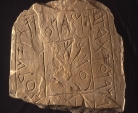 This collection, which he donated to the city of Beja, in 1987, was the result of more than 40 years efforts, dedicated to the research and archeological investigation. It constitutes one of the most important private archeological collections, and is witness of the importance, of the Humans presence, in the Alentejo region, for thousands of years.
This collection, which he donated to the city of Beja, in 1987, was the result of more than 40 years efforts, dedicated to the research and archeological investigation. It constitutes one of the most important private archeological collections, and is witness of the importance, of the Humans presence, in the Alentejo region, for thousands of years.
In 1989, the Regional Museum of Beja, reopens its 2nd. Floor, with the show of the Fernando Nunes Ribeiro archeological collection. In it, is depicted the search to have a panoramic archeological view, of the Beja district. By its richness, it merits particular reference the Southeast Bronzes, of the Iron Age and of the Roman Era.
In a small incursion into the pre-history, is found an array of Lithic and Languedocense items, which are, as well as a set of different pieces from more recent times, among which outstands a rare vase with an elliptic mouth, a collection of schist anthropomorphic figures, polished stone axes and a collection of arrows silex points, that emphasizes the importance of a hunting economy. From the Bronze Age there is a set of S. Vitoria ceramic vases, and an important series of tombstones, decorated with arms and utensils belonging to a culture which we, today, name as of the Southeast Bronze. This Culture was based on a sedentary economy, the agriculture, cattle raising and mining exploration. Of the Iron Age, are part a set of slabs, with the most ancient type of writing within the Iberian Peninsula. Known as the Iberian writing, it has been indecipherable until today, in spite of countless studies, done by different areas of specialists.
 The bronze spit, that belongs to the same period, also awaits a similarly in-depth work of investigation. However, preliminary studies points that it was used during religious cults..The countless finds of the roman period, proves the importance of the Alentejo region during the Roman Empire: Rich and fertile lands, rich copper, silver and gold mines, as one example, we can mention the ones from Vipasca-Aljustrel.
The bronze spit, that belongs to the same period, also awaits a similarly in-depth work of investigation. However, preliminary studies points that it was used during religious cults..The countless finds of the roman period, proves the importance of the Alentejo region during the Roman Empire: Rich and fertile lands, rich copper, silver and gold mines, as one example, we can mention the ones from Vipasca-Aljustrel.
These Roman relics of the past include: Mosaics, Glasses, Lucernas, Sigilata land, Columns without capital, Arms, Coins, Aras, and it all came from Villaes (old farms) where many of these finds are now located in what is called to-day Montes Alentejanos. In the show is also referenced a quantity of finds done in the historical downtown of Beja, that has slowly helped to reconstruct the City history. Finally, on one last panel, is shown the course of the Alentejo coins, from Alexander the Great until today. These coins, mentioned, were an important exchange currency for goods and services, and its importance in the economical relations with the different peoples and cultures, throughout the centuries.
